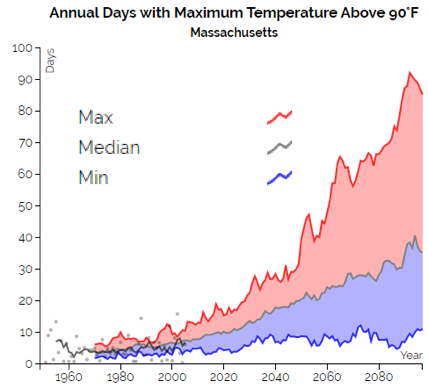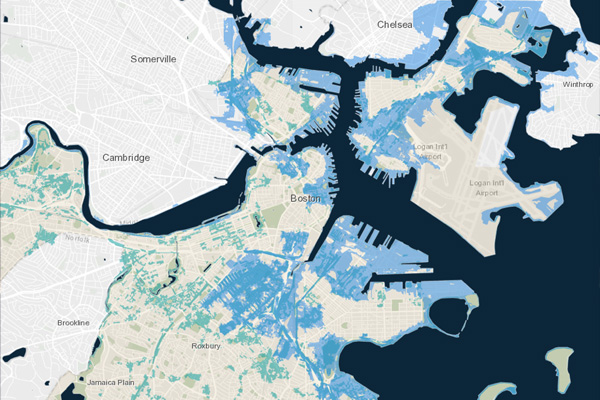

MassHousing Portfolio Assessment: Resiliency Planning
PROJECT BACKGROUND
Why Resilience?
Climate change is increasing the frequency and severity of extreme storms, exacerbating flooding, shifting precipitation patterns, and causing more heat waves throughout the United States and around the world. These climate change-related conditions disproportionately impact low-income communities. Owners and operators of affordable multifamily housing are positioned to help mitigate the negative impacts of climate change on their residents while protecting their building investments through successful resilience planning.
Massachusetts Climate Change Forecast
MASSACHUSETTS IS GETTING WARMER
Resilient MA estimated that the number of days in a year in which the temperature is above 90°F is expected to double by 2050 relative to the present. This number could triple if the worst case climate projections become reality.

(www.resilientma.org/datagrapher)
MASSACHUSETTS IS GETTING WETTER
Sea level rise and increases in extreme rainfall will result in increased flooding risk in many communities. The City of Boston has been spurred to action by this climate data and is developing neighborhood planning strategies and climate resilience projects to mitigate long term impacts.

Boston area.
(www.boston.gov/departments/environment/climate-ready-boston-map-explorer)
Low Cost / Low Intervention Resiliency Improvements
While the climate change related projections are daunting, there are some low-cost measures that affordable housing owners and managers can implement to protect people and buildings.
Source: Enterprise Green Communities: Ready to Respond, Strategies for Multifamily Building Resilience
PLAN
Develop an Emergency Management Plan: An emergency management plan (EMP) provides a structured checklist approach for housing organization operations during emergency events. An EMP promotes and streamlines coordination, communication, and information sharing that is specific to each community and its unique needs.
Creating Community Resilience Spaces: Designating a gathering space for residents during extreme events increases community resilience by connecting residents to each other, management staff, and response information.
Access to Potable Water: During extended shelter-in-place emergency events, access to potable water is critical. Collapsible water jugs or bottled water can be stored on site as a backup resource for an emergency event when power or the municipal water supply is interrupted for extended periods. This is especially important for taller buildings (typically five stories or more) that require pressure-boosting pumps to distribute potable water to units. An emergency water faucet at a location in the building that does not require pressure boosting pumps can allow for access to fresh water for filling containers.
PROTECT
Backwater Valves: If a building is vulnerable to stormwater flooding, a backwater valve can prevent stormwater backup from the street sewer system by sealing the building piping system if there is backflow.
Sump Pumps: For buildings at risk of water intrusion, a sump pump can help mitigate water damage and the potential for equipment damage and mold growth. The impact of this system is improved if it is connected to emergency back-up power.
Window Shading: Extreme heat events are a primary health risk to vulnerable populations, such as the infirm or elderly. To combat extended periods of elevated temperatures, interior or exterior window shading can be utilized to significantly reduce solar heat gain and extend duration of in-place sheltering. During non-emergency situations window shades can be used to reduce energy usage associated with cooling.
BACKUP POWER
Maintaining Backup Power to Critical Systems: During extended power outages, the extent of building systems that are connected to backup power may determine how long residents will be able to shelter in place and the extent of building damage that results from the event. When evaluating what systems to connect to back up power, it is important to consider your building’s population and any unique needs they may have. Backup power can be used to operate sump pumps to avoid water damage, enable telecom systems to communicate during an emergency, enable elevator operation to evacuate immobile occupants, provide domestic water delivery for pressure-boosted pumped systems, power refrigeration for food and medicine storage, extend emergency lighting duration, and enable heating and cooling equipment to maintain thermal comfort in designated areas of the building.
ADDING RESILIENCE TO REFINANCING AND RETROFIT SCHEDULE
Rehabilitation/Retrofit provides an important opportunity to improve the resilience of a building beyond what might be possible through low cost interventions. During early stage planning, teams should evaluate the risks and vulnerabilities for their property (both current and future risks based on climate models) and consider the corresponding resilience opportunities which could be integrated into the scope of rehabilitation improvements. Many times, essential capital improvements can be leveraged to improve resilience. In some circumstances, features that improve the resilience of the building also create energy savings.
Partner organizations:


